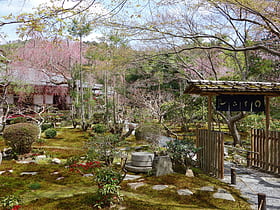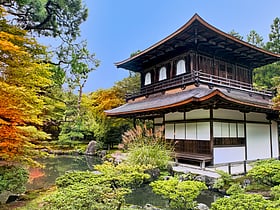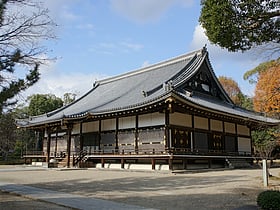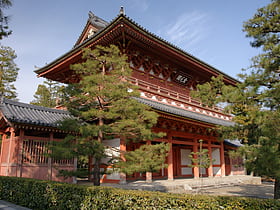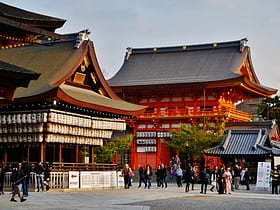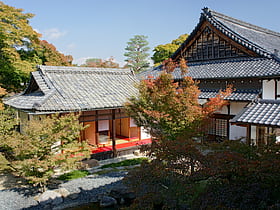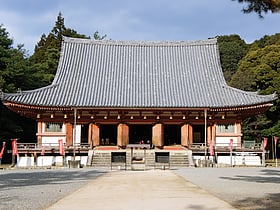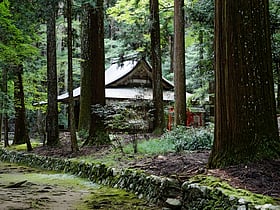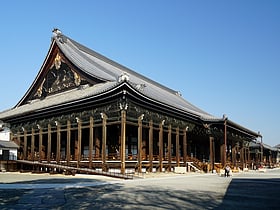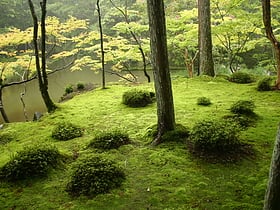Kyoto: Sacred and Religious Sites
Places and attractions in the Sacred and religious sites category
Categories
- Temple
- Sacred and religious sites
- Buddhist architecture
- Buddhist temple
- Museum
- Historical place
- Park
- Unesco
- Garden
- Art museum
- Specialty museum
- Street
- Universities and schools
- History museum
- Palace
- Area
- Theater
- Concerts and shows
- Shopping
- Bridge
- Neighbourhood
- Sport venue
- Sport
Ryōan-ji
Long-standing temple with a Zen rock garden Ryōan-ji, located in the historic city of Kyoto, Japan, is an iconic Zen Buddhist temple known for its enigmatic rock garden, which attracts visitors from around the world. Established in 1450 during the Muromachi period, the temple belongs to the Myoshinji school of...
Ginkaku-ji
Enduring Zen temple with scenic gardens Ginkaku-ji, also known as the Silver Pavilion, is a historic temple that graces the cultural tapestry of Kyoto, Japan. This Zen temple, formally named Jishō-ji, was constructed in 1482 as a retirement villa for the shogun Ashikaga Yoshimasa, who intended to cover the...
Ninna-ji
Buddhist temple with scenic grounds Ninna-ji is a historic temple that stands as a beacon of cultural heritage in the ancient city of Kyoto, Japan. This revered site, founded in the year 888, is a quintessential representation of Japanese religious architecture and traditional aesthetics.
Daitoku-ji
Buddhist temple site known for gardens Nestled in the northern part of Kyoto, Daitoku-ji stands as a testament to the city's deep-rooted Zen Buddhist traditions. This sprawling temple complex, established in the 14th century, is not only a place of religious significance but also a serene park that offers a...
Yasaka Shrine
Yasaka Shrine, nestled in the heart of Kyoto, is a beacon of tradition and an enduring testament to Japan's spiritual heritage. This historic Shinto shrine, also known as Gion Shrine, is renowned for its stunning architecture and its pivotal role in the city's cultural...
Tōfuku-ji
Scenic 13th-century Buddhist temple Tōfuku-ji, a Zen Buddhist temple, stands as a beacon of tranquility and historical significance in the culturally-rich city of Kyoto, Japan. Founded in 1236 during the Kamakura period, this temple is particularly renowned for its spectacular autumn foliage and the...
Tenryū-ji
Zen temple in a scenic, tranquil setting Tenryū-ji is a serene oasis nestled in the heart of Arashiyama, a scenic district on the western outskirts of Kyoto, Japan. Founded in 1339 by the shogun Ashikaga Takauji, this historic temple serves as the head temple of the Tenryū branch of Rinzai Zen Buddhism.
Sanjūsangen-dō
Sanjūsangen-dō, a revered temple situated in the heart of Kyoto, Japan, is a testament to the city's rich cultural and spiritual history. Established in 1164 and rebuilt in the 13th century after a fire, this temple is renowned for its impressive collection of...
Daigo-ji
Buddhist temple with gardens and a museum Daigo-ji, an ancient temple of profound historical significance, stands as a testament to the rich cultural heritage of Kyoto, Japan. Founded in the early Heian period, in 874, Daigo-ji is not merely a temple but an extensive complex that includes a pagoda, several...
Eikan-dō Zenrin-ji
Prominent Buddhist temple complex Eikan-dō Zenrin-ji, nestled amidst the vibrant hues of Kyoto's Higashiyama district, stands as a serene testament to the city's rich cultural and spiritual heritage. This historic temple, dating back to the Heian period, is a cornerstone of Japanese Pure Land Buddhism...
Daikaku-ji Temple
Buddhist temple with traditional gardens Daikaku-ji Temple is an emblem of serenity nestled in the ancient city of Kyoto, Japan. Established in the early Heian period, the temple originally served as a residence for Emperor Saga and was later converted into a Buddhist temple.
Kōdai-ji
Tranquil Buddhist temple with gardens Kōdai-ji, a serene Zen temple nestled in the heart of Kyoto, Japan, offers a tranquil escape from the hustle and bustle of the city. Founded in 1606 by Kita-no-Mandokoro in memory of her late husband, Toyotomi Hideyoshi, a prominent historical figure, the temple is a...
Kennin-ji
Buddhist temple with tea and a Zen garden Nestled in the heart of Kyoto, Japan, Kennin-ji stands as a serene testament to the city's rich Buddhist heritage. As the oldest Zen temple in Kyoto, this historical site offers a tranquil retreat from the bustling streets and a chance to immerse oneself in the...
Seimei Shrine
Seimei Shrine, a serene and historically rich Shinto shrine nestled in the heart of Kyoto, Japan, stands as a tribute to the revered Heian-era astrologer and diviner, Abe no Seimei. This tranquil site, enveloped by lush greenery, offers a glimpse into Japan's ancient...
Shōren-in
Shōren-in, a serene oasis nestled in the bustling city of Kyoto, Japan, is a historic temple that offers a tranquil retreat from the urban pace. Known for its intimate connection with the imperial family and its role as a residence for high-ranking monks, Shōren-in...
Shirakumo Shrine
Shirakumo Shrine is a Shinto shrine in Kyoto Gyoen National Garden, in Kyoto, Japan.
Higashi Hongan-ji
Buddhist temple with whimsical fountains Higashi Hongan-ji, or, ″the Eastern Monastery of the Original Vow″, is one of two dominant sub-sects of Shin Buddhism in Japan and abroad, the other being Nishi Honganji.
Kōzan-ji
Buddhist temple with a trove of art Kōzan-ji, officially Toganōsan Kōsan-ji, is a Buddhist temple of the Omuro sect of Shingon Buddhism in Umegahata Toganōchō, Ukyō Ward, Kyoto, Japan. Kōzan-ji is also known as Kōsan-ji and Toganō-dera.
Chion-in
Grand circa-1618 Buddhist temple complex Chion-in in Higashiyama-ku, Kyoto, Japan is the headquarters of the Jōdo-shū founded by Hōnen, who proclaimed that sentient beings are reborn in Amida Buddha's Western Paradise by reciting the nembutsu, Amida Buddha's name.
Matsunoo Taisha
Matsunoo Taisha, formerly Matsunoo Jinja, is a Shinto shrine located at the far western end of Shijō Street, approximately 1.3 kilometers south of the Arashiyama district of Kyoto. It is home to a spring at the base of the mountain, Arashiyama, that is believed to be blessed.
Adashino Nenbutsu-ji
Temple known for its memorial statues Adashino Nenbutsu-ji is a Buddhist temple in Ukyo-ku, Kyoto, Japan. In 811 Kūkai is said to have founded a temple, then Honen altered it to the present Nenbutsuji.
Hōnen-in
Hōnen-in is a Buddhist temple located in Sakyō-ku, Kyoto, western Japan. Honen-in is a single-estate temple located in Shikagaya, Sakyo-ku, Kyoto. It was originally part of the Jodo sect, but became independent and is now a single religious corporation. Its official name is Zenkisan Honen-in Manmukyoji Temple.
Konchi-in Temple
Konchi-in is a Buddhist temple in Sakyō-ku, Kyoto, western Japan. The temple is renowned for its Crane and Turtle Garden Japanese garden.
Kurama-dera
Ancient temple in forested mountains Kurama-dera is a temple in the far north of Kyoto, Japan which houses some National Treasures of Japan. It was a member of the Tendai sect and subordinate to Shōren-in from the 12th century until 1949 when it founded its own religious body.
Shōkoku-ji
Shōkoku-ji, formally identified as Mannen-zan Shōkoku Shōten Zenji, is a Buddhist temple in northern Kyoto, first founded in 1382 by Ashikaga Yoshimitsu, with the existing temple complex having undergone several periods of extensive reconstruction and rebuilding in the succeeding eras.
Hirano Shrine
Historic shrine with cherry blossoms The Hirano Shrine is a Shinto shrine in Kyoto. This shrine is known and popular for its gardens and many trees.
Sanzen-in
Buddhist temple and picturesque garden Sanzen-in is a Tendai school monzeki temple in Ōhara, Kyoto, Japan. The Heian period triad of Amida Nyorai flanked by attendants is a National Treasure.
Kamigamo Shrine
Kamo Shrine is a general term for an important Shinto sanctuary complex on both banks of the Kamo River in northeast Kyoto. It is centered on two shrines.
Shisen-dō
Historic Buddhist temple with gardens Shisen-dō is a Buddhist temple of the Sōtō Zen sect in Sakyō-ku, Kyoto, Japan. It is registered as a historic site of Japan. It stands on the grounds of its founder, the Edo period intellectual Ishikawa Jōzan, who established the temple in 1641.
Ryōzen Kannon
The Ryōzen Kannon is a war memorial commemorating the dead of the Pacific War located in Eastern Kyoto. The concrete and steel statue of the Bodhisattva Avalokiteśvara was built by Hirosuke Ishikawa and unveiled on 8 June 1955. The statue is 24 m high and weighs approximately 500 tons.
Taizō-in
Taizō-in is the oldest sub-temple of the Myōshin-ji Rinzai Zen Buddhist temple, situated in the northwest of Kyoto, Japan. It was founded by Zen priest Muinsoin in 1404.
Otagi Nenbutsu-ji
Buddhist temple with sculpted heads Otagi Nenbutsu-ji is a Buddhist temple in the Arashiyama neighborhood of Kyoto, Japan. Otagi Nenbutsu-ji was founded by Empress Shōtoku in the middle of the eighth century. Though was destroyed by the flooding of the Kamo River, it was rebuilt as an offshoot of Enryaku-ji, a nearby temple.
Nishi Hongan-ji
Nishi Hongan-ji is a Jōdo Shinshū Buddhist temple in the Shimogyō ward of Kyoto, Japan. It serves as the head temple of the sub-sect Honganji-ha.
Shinsenen
Shinsenen is a Shingon Japanese Buddhist temple located south of Nijō Castle in the approximate center of the modern city of Kyoto, Honshu, Japan. It was founded by Kūkai in 824 and predominantly consists of a large water garden centering about a pond. It is said to be the oldest existing garden in Kyoto.
Kibune Shrine
Small Shinto shrine in the hills Kifune Shrine is a Shinto shrine located at Sakyō-ku, Kyoto, Kyoto Prefecture Japan.
Toyokuni Shrine
Toyokuni Shrine is a Shinto shrine located in Higashiyama-ku, Kyoto, Japan. It was built in 1599 to commemorate Toyotomi Hideyoshi. It is the location of the first tamaya ever constructed, which was later destroyed by the Tokugawa clan.
Taimatsuden Inari Shrine
Taimatsuden Inari Shrine is an Inari shrine in Shimogyō-ku, Kyoto, Japan.
Nonomiya Shrine
Storied Shinto shrine to marriage Nonomiya Shrine, or the Shrine in the Country, is a Shinto shrine in the Arashiyama district on the west side of the city of Kyoto in Kyoto prefecture, Japan, close to its bamboo forest.
Umenomiya Shrine
Umenomiya Shrine is a Shinto shrine located in Ukyō-ku in Kyoto, Japan.
Saihō-ji
Buddhist temple with famed moss garden Saihō-ji is a Rinzai Zen Buddhist temple in Matsuo, Nishikyō Ward, Kyoto, Japan. The temple, which is famed for its moss garden, is commonly referred to as "Koke-dera", meaning "moss temple", while the formal name is "Kōinzan Saihō-ji".
Jingo-ji
Jingo-ji is a Buddhist temple in Kyoto. It stands on Mount Takao to the northwest of the center of the city. The temple adheres to Shingon Buddhism. Its principal image is a statue of Bhaisajyaguru, the Buddha of Healing or "Medicine Buddha".
Myōshin-ji
Temple complex with landscaped gardens Myōshin-ji is a temple complex in Kyoto, Japan, and head temple of the associated branch of Rinzai Zen Buddhism.
Sennyū-ji
Sennyū-ji, formerly written as Sen-yū-ji, is a Buddhist temple in Higashiyama-ku in Kyoto, Japan. For centuries, Sennyū-ji has been a mausoleum for noble families and members of the Imperial House of Japan.
Kōtō-in
Kōtō-in is a sub-temple of Daitoku-ji, Kyoto, Japan. It was founded by Hosokawa Tadaoki. There is a teahouse, the Shōkō-ken, and the gardens are celebrated for their momiji.
Miyake Hachimangū
Miyake-Hachimangū is a Shinto shrine, in Sakyo-ku, Kyoto, Japan. The shrine is famous for worship to beneficial to children, such as baby colic, academic achievement, safe delivery of childbirth. Because Mushi was thought to cause baby colic, the shrine also has worship for power to expel Mushi.
Map

